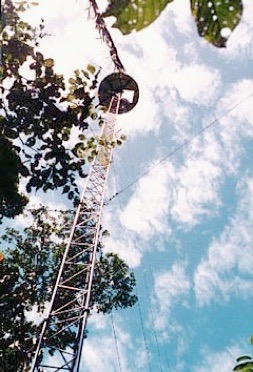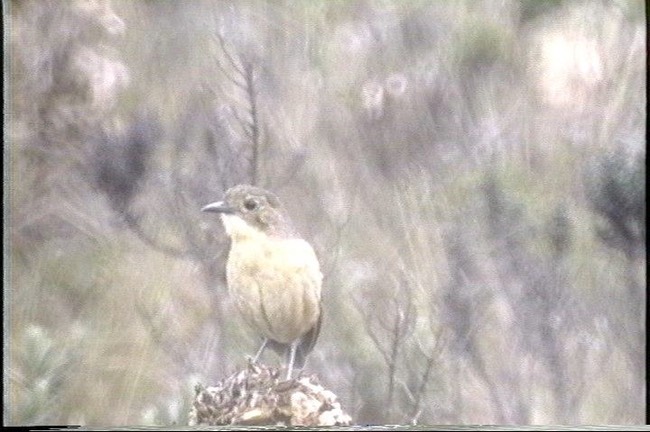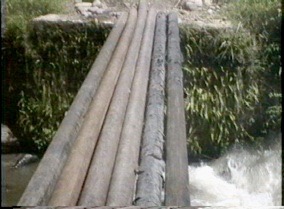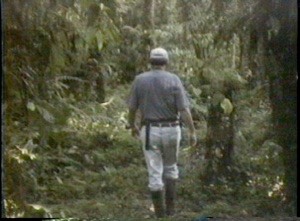Ecuador is a small country but it has attracted me to its jungles and mountain slopes several times. During a short three-week trip it is possible to bird the altisana (see the two video snippets of this area below) and the jungle, worlds away - just down the road.
At the bottom of this page there are links to the various videos of individual bird species I have made of my Ecuadorian trips (see also The Birds of Ecuador video portfolio). Photographs of some of the bird species of this area are included in The Birds of Ecuador photo gallery. A photograph of an Andean Cock-of-the-Rock on its nest, from 2010, is shown below.
Some of my notes from Ecuador are found below the following long-form videos - recorded a decade apart, the first in 1997 and the last in 2010.
Recorded in 1997, this video includes the following species; Tanager Finch, White-sided Flowerpiercer, Buff-tailed Coronet, Southern Rough-winged Swallow, Golden-olive Woodpecker, Great Jacamar, Crimson-rumped Toucanet, White-capped Dipper, Torrent Tyrannulet, Smooth-billed Ani, Golden-headed Quetzal, Tawny-bellied Hermit, Ornate Flycatcher, Pacific Hornero, Tawny Antpitta, Andean Cock-of-the-Rock, Blue-gray Tanager, and Yellow-browed Sparrow.
Recorded in 2010, this video includes the following (mostly bird) species; Buff-tailed Coronet, Red-headed Barbet, Fawn-breasted Brilliant, Green-crowned Brilliant, Chestnut-capped Brush-Finch, Slaty Brush-Finch, Andean Emerald, Western Emerald, White-sided Flowerpiercer, Golden-crowned Flycatcher, Rufous-tailed Hummingbird, Brown Inca, Golden-winged Manakin, Blue-winged Mountain-Tanager, White-throated Quail-Dove, Golden-headed Quetzal, Booted Racket-tail, Neotropical Red Squirrel (mammal), Buff-winged Starfrontlet, Violet-tailed Sylph, Blue-Gray Tanager, Golden Tanager, Golden-naped Tanager, Lemon-rumped Tanager, Silver-throated Tanager, Green Thorntail, Crimson-rumped Toucanet, Brown Violetear, Green Violetear, Sparkling Violetear, Red-eyed Vireo, Blackburnian Warbler, Russet-crowned Warbler, and Slate-throated Whitestart.
Notes From These Trips

I am at the base of the canopy tower at Jatun Sacha Biological Station in Ecuador, near Tena (November 1997). It is early and already hot, I’m looking at the guy lines of this tower with a certain dismay. It is very quiet, a bird calls somewhere to the right, two butterflies pass by, there is no wind, not a leaf is moving.
Back to the tower, although I would rather not. It is made of re-bar which has been welded together. There are three sides, each side about 18 inches wide. A triangular matrix of cross bars adds support to the sides. The supporting cables are not taut. The tower looks like a radio beacon tower with limp cables, at the very top there is a small platform which is 2 meters in diameter. (The upper part of the tower at Jatun Sacha is shown to the right.)
On my back I have a pack of camera equipment and water, in my hands I hold a climbing harness. I put the harness on and place my right foot on a cross bar and start the climb up the outside of the tower. The harness has two slings with carabineers. Unsnap the lower carabineer from the re-bar and reattach it as far up as possible. Climb some more, snap and unsnap. Climbing the outside of this tower is tiring and it is hot, the higher I get the more the tower twists and sways, the cables are not taut.
One hundred and twenty feet up I come to the underside of the platform, which is made of aluminum, there is a trapdoor near the center where the tower pierces the platform. I push the trapdoor open, take my pack off -- making sure I am always holding on to the tower with one hand, and push the pack up through the door and onto the platform. I follow.
Three things strike me immediately; 1) I can see forever across the top of the trees; 2) the tower sways and twists in a strange way whenever I make the smallest of moves; and 3) the guard rail is made of re-bar and is six inches high.
I sit. My legs go to sleep but I am reluctant to move because the tower will move. The November sun beats down in an unrestricted manner, I am hot, I drink all of my water.
I stay as long as I can because it is as beautiful as it is scary. Finally I know that I have to go or I will be to weak to make it down. I open the trapdoor and repeat the process of coming up, as I go down. Even though I am very thirsty I sit at the bottom regaining my composure. I do not look at the tower.
AND - Again from Ecuador, this time an exert about a trip in 2010.
The next day we were in the lowlands at the Rio Silanche Reserve which has a canopy tower - the reason I wanted to visit the site. I headed to the tower immediately and spent the morning and part of the afternoon there -- until the heat drove me down. I must say that the guides did their best to hang in there and stayed with me most of the time, major boredom for them but I could see that the place had great (unrealized on this date) potential -- video-wise. That being said, the host of species taped included: Pallid Dove; Guayaquil, Black-cheeked, and Lineated Woodpecker; Black-headed Tody-Flycatcher; and Choco Tyrannulet. We walked some trails in late afternoon and then headed back to the lodge (1.5 hours away) for an early day.
Two short videos from the Antisana of Ecuador are presented below:
The trip in 1997 was full of adventures, including this from my notes at the time:
I’m high in the Andes of Ecuador (November 1997), I am driving a small four-wheel drive along a narrow road cut into a cliff. The road keeps getting more narrow, I have just passed a turn around but I want to see what is around the curve. The cliff to my right drops a thousand feet or so, on my left it rises vertically for hundreds of feet, the track has become just slightly wider than the 4x4. I have to turn around at the first opportunity. I inch around the curve.
“Holy shit”
There is no road, no, there it is forty feet ahead, but between here and there - there is no road. I sit, what now, this is scary.
The cliff on my left is very close but I am able to open my door a few inches and squeeze out of the vehicle. I need to reconnoiter. This is bad, it is a long way down, it is a long way back to the turnout, the road is rocky, the road is narrow, there is no room to make a mistake.
If I start walking now I may be able to get to a farm by nightfall, from there I could get to a phone and tell the rental company that if they want their vehicle they can come and get it.
I walk around in circles for a while. I decide that I will try to back it out. I walk around in circles some more.
I squeeze back in and start to back up, there is a large rock in the road which I will have to back over, I put the truck in four-wheel drive and inch up over the rock, not to much gas, there is a curve, to much gas and I will be test flying this thing. To little and I will not get over the rock.
Gradually, slowly, I back along the track, two hours for a hundred yards, I reach the turn out. I get out, I walk around in circles, it takes half-an-hour to stop shaking.
There will be no birding here.
It is later the same day. I am driving down a wonderfully wide mountain road (it is almost two lanes) feeling quite sick -- high levels of stress will do that. I do not want to bird, I want to get back to my room, curl up in my bed, and suck my thumb. I am wiped.
Six school kids, maybe second graders, are walking along the road. They see me coming and fan out making a human road block, could they be some of the fabled Ecuadorian bandits?
Nope, seems they just want a ride to school. They pile in, we lumber down the road, they laugh and giggle at the exotic North American they have way-laid.
We come to their school, a small building joined to the road by a narrow bridge over a ravine. Off they go laughing and waving.
(P. S. - In 2010 I returned to the spots referenced above. The road is still gone - the section where I had to back up is now part of a hiking trail, much better for birding. The school, with a foot bridge access, is still there and still full of laughing children.)
Also from my notes of a trip to the area in 1997-
On November 19 (Wed) I traveled from Tinalandia to San Isidro, via the Papallacta Pass. The road going up the west side of the pass is two-lane and paved. It is steep, my Kia Sportage was down in 2nd gear quite a bit of the time.
At the crest of the pass, there is a dirt road off to your left (north) which soon forks. The right fork goes to the antenna towers near the top of the mountain. “Best” and other books refer to a gate near the bottom. There are metal posts on either side of the road where a gate could clearly be, but when I was there, there was no gate. There were no issues associated with going up to the top (except that once when I stopped [about 3/4 of the way to the top] the Sportage could not get up enough steam to get going again so I had to back down to the bottom and get a running start to make it to the top).
I met a birder who was walking down from the top, he had taken a bus to the pass and then walked to the top. He said the altitude was bothering him a bit but seemed to be enjoying himself. The altitude was noticeable, I felt a bit light headed and found myself taking deep breathes. At home in Portland we are at about 50 meters above sea level but I haven't had difficulty with altitude in the past. I think there is a big difference between 10,000-11,000 feet in the Cascades and Ruby Mountains and 4,100 meters, though. That additional 2-3,000 feet is really noticeable.

On the road to the antennas I added Carunculated Caracara, Grass Wren, Tawny Antpitta (photo right), Barwinged Cinclode, Andean Tit-Spinetail, Plain Capped Ground-Tyrant, Plumbeous Sierra-Finch, Stout-billed Cinclode, Ecuadorian Hillstar, Spot-billed Ground-Tyrant, Black-billed Shrike-Tyrant, Many-striped Canastro, and Brown-backed Chat-Tyrant to my life list. The Tawny Antpittas put on quite a show, sitting on top of small bushes and running along the ground, their calls were everywhere. The Ecuadorian Hillstar was quite exciting, a Hummingbird that hangs out near the ground (there isn't any high vegetation). I had nice looks at all of these birds -- quite a show. (No Condor and no ducks.)
On November 27 I returned to the pass enroute to Quito. At the antenna towers, in thick fog, I added Rufous-bellied Seed-Snipe to my life list. The road down the east side of the pass is gravel but it is in pretty good shape. There was a lot of truck traffic and it was very dusty.
I spent some time in the Mindo Valley (roughly 5,000 feet in elevation) in Ecuador. That time is full of memories for me. My first encounter with the Mindo Valley was not a happy circumstance, my trip was coming unraveled the equipment had gotten wet and I was generally despondent. I found a small hotel with a room where I could sit in the corner and suck my thumb, generally feeling about two years old. I decided that behavior was unacceptable so I bought a cold beer and sat on the balcony watching it rain and sucked my thumb and drank my beer -- that was much better.
The rain stopped, it generally does at some point, and I headed off to the other side of the valley to a trail which led up into the forest. Along this trail I found Ornate Flycatcher, several hummingbirds, and a Golden-headed Quetzal (photo right). It showered on and off during the day but I was in much better spirits, feeling that things were under control and I was back in my element.


A day later I find that I can’t drive to where I want to go. The rains have washed out a bridge and it is not due to be replaced anytime soon. The locals have installed pipe and poles to make a foot bridge (photo right) so off I go up the road - enjoying every bit of it. A morpho flies up the road, blue flashing dramatically as it passes through the dabbled light.
I stop to tape a bird in the top of the tree, a farmer who has been working his fields stops to talk to me, he takes a gander through the camera - smiles - we communicate, not with words but rather with a shared appreciation of the world, he waves his machete up the road and gets me to understand there is a good bird spot up the hill, he draws a mud map for me and off he goes - a friendly encounter with a guy waving a machete in the middle of no-where. Something that I have come to take for granted in my travels in the American Tropics.
The Rio Mindo (photo right) turned out to be a wonderful place for birds like the White-capped Dipper and Torrent Tyrannulet.
The next day the rains returned and I was sequestered to the balcony to drink beer and tape birds. I sit in a very comfortable chair, binoculars in my lap, a cold beer on the table to my right, tripod and camera to my left, and my eyes - my eyes are everywhere.
This has turned out to be a remarkable spot for taping birds. This afternoon I have seen five new species - five life birds while sitting in a chair! This Crimson-rumped Toucanet (pictured below right) has sat in the coffee plant fifteen feet away eating coffee beans for an hour or so. This birding-videotaping stuff can be so trying.
After spending time on the west side of the Andes and time in the high Andes, I have ventured down the east slope to Cabanas San Isidro. I have come to tape the Andean Cock-of-the-Rock and anything else which presents itself. The trail system here is very good and the reserve is over 1,300 acres large. As in most places in the tropics, rubber boots are the preferred footwear (photo below right). Even so, as I ventured along one of the trails I stepped on a level piece of trail and sank through brown mucky syrup to my knee in a nanosecond - reminds me of a time on Mt. Rainier in Washington, USA - but that is a story for another time.
After dinner one night the owner showed me their insect collection - drawers and drawers of insect specimens collected from the reserve. Truly an excellent representation, amazing in its beauty and scientific value.

As I wandered back to my Cabana sans flashlight I was mulling the scientific value vs. the life of an insect issue when suddenly I heard it. A loud hum, growing louder and louder, coming through the dark night, there was only the faint glimmer of the trail at my feet, everything else was dark - except a trillion stars or so -- and the sound -- louder and louder. Then, suddenly, a thump right on my heart, I yelped, scratching at my chest, trying to get it off. Finally it was off and I was scurrying to my cabana, heart rate elevated without the pain of miles of walking.
The next day I asked. Probably a Hercules Beetle they said, big suckers. Don’t wear light shirts when you walk at night.
Of course, on every other night I made the walk back to my cabana with a flashlight (which I kept off) and a light shirt. The hum would turn to a roar, there would be the impact on my chest, the flashlight would come on -- oh what glory.
My travels in search of birds have taken me across a variety of roads. Roads as diverse as the bridges of the Pantanal and the interstate highway near my home. While traveling in Ecuador (November) I remember three instances which are vaguely related to roads.
On the day of my arrival in 1997 I rented a car and headed for Bellavista Lodge, a tremendous thunderstorm moved in and I found myself trying to navigate in a foreign place where I could barely see the road. Following the map I had, I searched for a side road which I finally concluded was a track to the left. Up the road I went, brush often hitting both sides of the vehicle, water poured down the road, concealing the large ruts (valleys?) - making for a bumpy and sometimes exciting ride. The water poured from the sky, the water poured down the road, thunder sounded directly overhead, I wasn’t sure it was the right road and if it wasn’t -- there was no place to turn around. It was the right road, I did arrive safely, etc. etc.
Later in the trip I birded the old road from the Tinalandia area to Quito, the road via Chiriboga. Again I was not sure if I was on the right road - not that it mattered a lot, I knew the way back down (my route finding is excellent on one-way tracks without side roads) but it would be nice to know. As I was taping an Ornate Flycatcher a car came down the road I flagged it to a stop and asked if this was the way to get to Quito -- the driver looked at me, looked down the mass of ruts and rock which was this road, looked across the valley to the new road to Quito - the nice paved road to Quito, looked back at me, shook his head and said “Si”.
On the last occasion I was heading up the east side of the Andes toward the Papallacta Pass when I was stopped at a Military checkpoint. The guy in charge borrowed my binoculars and walked around for ten minutes or so looking at things. I waited. He gave them back. Off I went.
LINKS TO VIDEO OF INDIVIDUAL SPECIES
Mountain-Tanager, Black-chinned
Mountain-Tanager, Scarlet-bellied
Tody-Flycatcher, Rufous-crowned